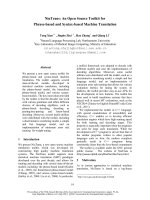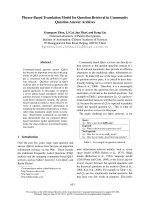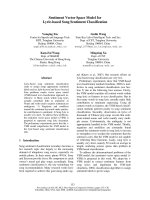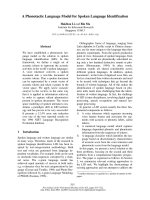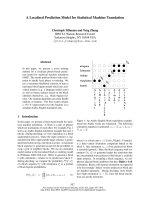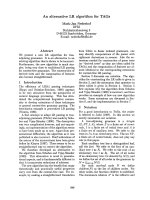Báo cáo khoa học: "An Effective Two-Stage Model for Exploiting Non-Local Dependencies in Named Entity Recognition" pdf
Bạn đang xem bản rút gọn của tài liệu. Xem và tải ngay bản đầy đủ của tài liệu tại đây (107.47 KB, 8 trang )
Proceedings of the 21st International Conference on Computational Linguistics and 44th Annual Meeting of the ACL, pages 1121–1128,
Sydney, July 2006.
c
2006 Association for Computational Linguistics
An Effective Two-Stage Model for Exploiting Non-Local Dependencies in
Named Entity Recognition
Vijay Krishnan
Computer Science Department
Stanford University
Stanford, CA 94305
Christopher D. Manning
Computer Science Department
Stanford University
Stanford, CA 94305
Abstract
This paper shows that a simple two-stage
approach to handle non-local dependen-
cies in Named Entity Recognition (NER)
can outperform existing approaches that
handle non-local dependencies, while be-
ing much more computationally efficient.
NER systems typically use sequence mod-
els for tractable inference, but this makes
them unable to capture the long distance
structure present in text. We use a Con-
ditional Random Field (CRF) based NER
system using local features to make pre-
dictions and then train another CRF which
uses both local information and features
extracted from the output of the first CRF.
Using features capturing non-local depen-
dencies from the same document, our ap-
proach yields a 12.6% relative error re-
duction on the F1 score, over state-of-the-
art NER systems using local-information
alone, when compared to the 9.3% relative
error reduction offered by the best systems
that exploit non-local information. Our
approach also makes it easy to incorpo-
rate non-local information from other doc-
uments in the test corpus, and this gives
us a 13.3% error reduction over NER sys-
tems using local-information alone. Ad-
ditionally, our running time for inference
is just the inference time of two sequen-
tial CRFs, which is much less than that
of other more complicated approaches that
directly model the dependencies and do
approximate inference.
1 Introduction
Named entity recognition (NER) seeks to lo-
cate and classify atomic elements in unstructured
text into predefined entities such as the names
of persons, organizations, locations, expressions
of times, quantities, monetary values, percent-
ages, etc. A particular problem for Named En-
tity Recognition(NER) systems is to exploit the
presence of useful information regarding labels as-
signed at a long distance from a given entity. An
example is the label-consistency constraint that if
our text has two occurrences of New York sepa-
rated by other tokens, we would want our learner
to encourage both these entities to get the same la-
bel.
Most statistical models currently used for
Named Entity Recognition, use sequence mod-
els and thereby capture local structure. Hidden
Markov Models (HMMs) (Leek, 1997; Freitag
and McCallum, 1999), Conditional Markov Mod-
els (CMMs) (Borthwick, 1999; McCallum et al.,
2000), and Conditional Random Fields (CRFs)
(Lafferty et al., 2001) have been successfully em-
ployed in NER and other information extraction
tasks. All these models encode the Markov prop-
erty i.e. labels directly depend only on the labels
assigned to a small window around them. These
models exploit this property for tractable com-
putation as this allows the Forward-Backward,
Viterbi and Clique Calibration algorithms to be-
come tractable. Although this constraint is essen-
tial to make exact inference tractable, it makes us
unable to exploit the non-local structure present in
natural language.
Label consistency is an example of a non-local
dependency important in NER. Apart from label
consistency between the same token sequences,
we would also like to exploit richer sources of de-
pendencies between similar token sequences. For
example, as shown in Figure 1, we would want
it to encourage Einstein to be labeled “Person” if
there is strong evidence that Albert Einstein should
be labeled “Person”. Sequence models unfortu-
1121
told that Albert Einstein proved
on seeing Einstein at the
Figure 1: An example of the label consistency problem. Here we would like our model to encourage entities Albert Einstein
and Einstein to get the same label, so as to improve the chance that both are labeled PERSON.
nately cannot model this due to their Markovian
assumption.
Recent approaches attempting to capture non-
local dependencies model the non-local dependen-
cies directly, and use approximate inference al-
gorithms, since exact inference is in general, not
tractable for graphs with non-local structure.
Bunescu and Mooney (2004) define a Rela-
tional Markov Network (RMN) which explicitly
models long-distance dependencies, and use it to
represent relations between entities. Sutton and
McCallum (2004) augment a sequential CRF with
skip-edges i.e. edges between different occur-
rences of a token, in a document. Both these
approaches use loopy belief propagation (Pearl,
1988; Yedidia et al., 2000) for approximate infer-
ence.
Finkel et al. (2005) hand-set penalties for incon-
sistency in entity labeling at different occurrences
in the text, based on some statistics from training
data. They then employ Gibbs sampling (Geman
and Geman, 1984) for dealing with their local fea-
ture weights and their non-local penalties to do ap-
proximate inference.
We present a simple two-stage approach where
our second CRF uses features derived from the
output of the first CRF. This gives us the advan-
tage of defining a rich set of features to model
non-local dependencies, and also eliminates the
need to do approximate inference, since we do not
explicitly capture the non-local dependencies in a
single model, like the more complex existing ap-
proaches. This also enables us to do inference ef-
ficiently since our inference time is merely the in-
ference time of two sequential CRF’s; in contrast
Finkel et al. (2005) reported an increase in running
time by a factor of 30 over the sequential CRF,
with their Gibbs sampling approximate inference.
In all, our approach is simpler, yields higher
F1 scores, and is also much more computationally
efficient than existing approaches modeling non-
local dependencies.
2 Conditional Random Fields
We use a Conditional Random Field (Lafferty et
al., 2001; Sha and Pereira, 2003) since it rep-
resents the state of the art in sequence model-
ing and has also been very effective at Named
Entity Recognition. It allows us both discrim-
inative training that CMMs offer as well and
the bi-directional flow of probabilistic information
across the sequence that HMMs allow, thereby
giving us the best of both worlds. Due to the
bi-directional flow of information, CRFs guard
against the myopic locally attractive decisions that
CMMs make. It is customary to use the Viterbi al-
gorithm, to find the most probably state sequence
during inference. A large number of possibly re-
dundant and correlated features can be supplied
without fear of further reducing the accuracy of
a high-dimensional distribution. These are well-
documented benefits (Lafferty et al., 2001).
2.1 Our Baseline CRF for Named Entity
Recognition
Our baseline CRF is a sequence model in which la-
bels for tokens directly depend only on the labels
corresponding to the previous and next tokens. We
use features that have been shown to be effective
in NER, namely the current, previous and next
words, character n-grams of the current word, Part
of Speech tag of the current word and surround-
ing words, the shallow parse chunk of the current
word, shape of the current word, the surrounding
word shape sequence, the presence of a word in a
left window of size 5 around the current word and
the presence of a word in a left window of size 5
around the current word. This gives us a compet-
itive baseline CRF using local information alone,
whose performance is close to the best published
local CRF models, for Named Entity Recognition
3 Label Consistency
The intuition for modeling label consistency is
that within a particular document, different occur-
1122
Document Level Statistics Corpus Level Statistics
PER LOC ORG MISC PER LOC ORG MISC
PER 3141 4 5 0 33830 113 153 0
LOC 6436 188 3 346966 6749 60
ORG 2975 0 43892 223
MISC 2030 66286
Table 1: Table showing the number of pairs of different occurrences of the same token sequence, where one occurrence is given
a certain label and the other occurrence is given a certain label. We show these counts both within documents, as well as over
the whole corpus. As we would expect, most pairs of the same entity sequence are labeled the same(i.e. the diagonal has most
of the density) at both the document and corpus levels. These statistics are from the CoNLL 2003 English training set.
Document Level Statistics Corpus Level Statistics
PER LOC ORG MISC PER LOC ORG MISC
PER 1941 5 2 3 9111 401 261 38
LOC 0 167 6 63 68 4560 580 1543
ORG 22 328 819 191 221 19683 5131 4752
MISC 14 224 7 365 50 12713 329 8768
Table 2: Table showing the number of (token sequence, token subsequence) pairs where the token sequence is assigned a certain
entity label, and the token subsequence is assigned a certain entity label. We show these counts both within documents, as well
as over the whole corpus. Rows correspond to sequences, and columns to subsequences. These statistics are from the CoNLL
2003 English training set.
rences of a particular token sequence (or similar
token sequences) are unlikely to have different en-
tity labels. While this constraint holds strongly
at the level of a document, there exists additional
value to be derived by enforcing this constraint
less strongly across different documents. We want
to model label consistency as a soft and not a hard
constraint; while we want to encourage different
occurrences of similar token sequences to get la-
beled as the same entity, we do not want to force
this to always hold, since there do exist exceptions,
as can be seen from the off-diagonal entries of ta-
bles 1 and 2.
A named entity recognition system modeling
this structure would encourage all the occurrences
of the token sequence to the same entity type,
thereby sharing evidence among them. Thus, if
the system has strong evidence about the label of
a given token sequence, but is relatively unsure
about the label to be assigned to another occur-
rence of a similar token sequence, the system can
gain significantly by using the information about
the label assigned to the former occurrence, to la-
bel the relatively ambiguous token sequence, lead-
ing to accuracy improvements.
The strength of the label consistency constraint,
can be seen from statistics extracted from the
CoNLL 2003 English training data. Table 1 shows
the counts of entity labels pairs assigned for each
pair of identical token sequences both within a
document and across the whole corpus. As we
would expect, inconsistent labelings are relatively
rare and most pairs of the same entity sequence
are labeled the same(i.e. the diagonal has most
of the density) at both the document and corpus
levels. A notable exception to this is the labeling
of the same text as both organization and location
within the same document and across documents.
This is a due to the large amount of sports news in
the CoNLL dataset due to which city and country
names are often also team names. We will see that
our approach is capable of exploiting this as well,
i.e. we can learn a model which would not pe-
nalize an Organization-Location inconsistency as
strongly as it penalizes other inconsistencies.
In addition, we also want to model subsequence
constraints: having seen Albert Einstein earlier in
a document as a person is a good indicator that a
subsequent occurrence of Einstein should also be
labeled as a person. Here, we would expect that a
subsequence would gain much more by knowing
the label of a supersequence, than the other way
around.
However, as can be seen from table 2, we
find that the consistency constraint does not hold
nearly so strictly in this case. A very common case
of this in the CoNLL dataset is that of documents
containing references to both The China Daily, a
newspaper, and China, the country (Finkel et al.,
2005). The first should be labeled as an organiza-
tion, and second as a location. The counts of sub-
sequence labelings within a document and across
documents listed in Table 2, show that there are
many off-diagonal entries: the China Daily case is
among the most common, occurring 328 times in
the dataset. Just as we can model off-diagonal pat-
1123
terns with exact token sequence matches, we can
also model off-diagonal patterns for the token sub-
sequence case.
In addition, we could also derive some value by
enforcing some label consistency at the level of
an individual token. Obviously, our model would
learn much lower weights for these constraints,
when compared to label consistency at the level
of token sequences.
4 Our Approach to Handling non-local
Dependencies
To handle the non-local dependencies between
same and similar token sequences, we define three
sets of feature pairs where one member of the fea-
ture pair corresponds to a function of aggregate
statistics of the output of the first CRF at the doc-
ument level, and the other member corresponds
to a function of aggregate statistics of the out-
put of the first CRF over the whole test corpus.
Thus this gives us six additional feature types for
the second round CRF, namely Document-level
Token-majority features, Document-level Entity-
majority features, Document-level Superentity-
majority features, Corpus-level Token-majority
features, Corpus-level Entity-majority features
and Corpus-level Superentity-majority features.
These feature types are described in detail below.
All these features are a function of the output
labels of the first CRF, where predictions on the
test set are obtained by training on all the data, and
predictions on the train data are obtained by 10
fold cross-validation (details in the next section).
Our features fired based on document and corpus
level statistics are:
• Token-majority features: These refer to the
majority label assigned to the particular to-
ken in the document/corpus. Eg: Suppose
we have three occurrences of the token Aus-
tralia, such that two are labeled Location
and one is labeled Organization, our token-
majority feature would take value Location
for all three occurrences of the token. This
feature can enable us to capture some depen-
dence between token sequences correspond-
ing to a single entity and having common to-
kens.
• Entity-majority features: These refer to the
majority label assigned to the particular en-
tity in the document/corpus. Eg: Suppose we
have three occurrences of the entity sequence
(we define it as a token sequence labeled as a
single entity by the first stage CRF) Bank of
Australia, such that two are labeled Organi-
zation and one is labeled Location, our entity-
majority feature would take value Organiza-
tion for all tokens in all three occurrences of
the entity sequence. This feature enables us
to capture the dependence between identical
entity sequences. For token labeled as not a
Named Entity by the first CRF, this feature
returns the majority label assigned to that to-
ken when it occurs as a single token named
entity.
• Superentity-majority features: These re-
fer to the majority label assigned to superse-
quences of the particular entity in the docu-
ment/corpus. By entity supersequences, we
refer to entity sequences, that strictly contain
within their span, another entity sequence.
For example, if we have two occurrences of
Bank of Australia labeled Organization and
one occurrence of Australia Cup labeled Mis-
cellaneous, then for all occurrences of the en-
tity Australia, the superentity-majority fea-
ture would take value Organization. This fea-
ture enables us to take into account labels as-
signed to supersequences of a particular en-
tity, while labeling it. For token labeled as not
a Named Entity by the first CRF, this feature
returns the majority label assigned to all enti-
ties containing the token within their span.
The last feature enables entity sequences to
benefit from labels assigned to entities which
are entity supersequences of it. We attempted
to add subentity-majority features, analogous to
the superentity-majority features to model depen-
dence on entity subsequences, but got no bene-
fit from it. This is intuitive, since the basic se-
quence model would usually be much more cer-
tain about labels assigned to the entity superse-
quences, since they are longer and have more con-
textual information. As a result of this, while
there would be several cases in which the basic
sequence model would be uncertain about labels
of entity subsequences but relatively certain about
labels of token supersequences, the converse is
very unlikely. Thus, it is difficult to profit from
labels of entity subsequences while labeling en-
tity sequences. We also attempted using more fine
1124
grained features corresponding to the majority la-
bel of supersequences that takes into account the
position of the entity sequence in the entity su-
persequence(whether the entity sequence occurs in
the start, middle or end of the supersequence), but
could obtain no additional gains from this.
It is to be noted that while deciding if to-
ken sequences are equal or hold a subsequence-
supersequence relation, we ignore case, which
clearly performs better than being sensitive to
case. This is because our dataset contains sev-
eral entities in allCaps such as AUSTRALIA, es-
pecially in news headlines. Ignoring case enables
us to model dependences with other occurrences
with a different case such as Australia.
It may appear at first glance, that our frame-
work can only learn to encourage entities to switch
to the most popular label assigned to other occur-
rences of the entity sequence and similar entity se-
quences. However this framework is capable of
learning interesting off-diagonal patterns as well.
To understand this, let us consider the example of
different occurrences of token sequences being la-
beled Location and Organization. Suppose, the
majority label of the token sequence is Location.
While this majority label would encourage the sec-
ond CRF to switch the labels of all occurrences
of the token sequence to Location, it would not
strongly discourage the CRF from labeling these
as Organization, since there would be several oc-
currences of token sequences in the training data
labeled Organization, with the majority label of
the token sequence being Location. However it
would discourage the other labels strongly. The
reasoning is analogous when the majority label is
Organization.
In case of a tie (when computing the majority
label), if the label assigned to a particular token
sequence is one of the majority labels, we fire the
feature corresponding to that particular label being
the majority label, instead of breaking ties arbi-
trarily. This is done to encourage the second stage
CRF to make its decision based on local informa-
tion, in the absence of compelling non-local infor-
mation to choose a different label.
5 Advantages of our approach
With our two-stage approach, we manage to get
improvements on the F1 measure over existing ap-
proaches that model non-local dependencies. At
the same time, the simplicity of our two-stage ap-
proach keeps inference time down to just the in-
ference time of two sequential CRFs, when com-
pared to approaches such as those of Finkel et al.
(2005) who report that their inference time with
Gibbs sampling goes up by a factor of about 30,
compared to the Viterbi algorithm for the sequen-
tial CRF.
Below, we give some intuition about areas for
improvement in existing work and explain how
our approach incorporates the improvements.
• Most existing work to capture label-
consistency, has attempted to create all
n
2
pairwise dependencies between the different
occurrences of an entity, (Finkel et al., 2005;
Sutton and McCallum, 2004), where n is
the number of occurrences of the given
entity. This complicates the dependency
graph making inference harder. It also leads
to the penalty for deviation in labeling to
grow linearly with n, since each entity would
be connected to Θ(n) entities. When an
entity occurs several times, these models
would force all occurrences to take the same
value. This is not what we want, since
there exist several instances in real-life data
where different entities like persons and
organizations share the same name. Thus,
our approach makes a certain entity’s label
depend on certain aggregate information of
other labels assigned to the same entity, and
does not enforce pairwise dependencies.
• We also exploit the fact that the predictions
of a learner that takes non-local dependen-
cies into account would have a good amount
of overlap with a sequential CRF, since the
sequence model is already quite competitive.
We use this intuition to approximate the ag-
gregate information about labels assigned to
other occurrences of the entity by the non-
local model, with the aggregate information
about labels assigned to other occurrences of
the entity by the sequence model. This intu-
ition enables us to learn weights for non-local
dependencies in two stages; we first get pre-
dictions from a regular sequential CRF and
in turn use aggregate information about pre-
dictions made by the CRF as extra features to
train a second CRF.
• Most work has looked to model non-local de-
pendencies only within a document (Finkel
1125
et al., 2005; Chieu and Ng, 2002; Sutton
and McCallum, 2004; Bunescu and Mooney,
2004). Our model can capture the weaker but
still important consistency constraints across
the whole document collection, whereas pre-
vious work has not, for reasons of tractabil-
ity. Capturing label-consistency at the level
of the whole test corpus is particularly helpful
for token sequences that appear only once in
their documents, but occur a few times over
the corpus, since they do not have strong non-
local information from within the document.
• For training our second-stage CRF, we need
to get predictions on our train data as well as
test data. Suppose we were to use the same
train data to train the first CRF, we would get
unrealistically good predictions on our train
data, which would not be reflective of its per-
formance on the test data. One option is to
partition the train data. This however, can
lead to a drop in performance, since the sec-
ond CRF would be trained on less data. To
overcome this problem, we make predictions
on our train data by doing a 10-fold cross val-
idation on the train data. For predictions on
the test data, we use all the training data to
train the CRF. Intuitively, we would expect
that the quality of predictions with 90% of
the train data would be similar to the qual-
ity of predictions with all the training data. It
turns out that this is indeed the case, as can
be seen from our improved performance.
6 Experiments
6.1 Dataset and Evaluation
We test the effectiveness of our technique
on the CoNLL 2003 English named en-
tity recognition dataset downloadable from
The data
comprises Reuters newswire articles annotated
with four entity types: person (PER), location
(LOC), organization (ORG), and miscellaneous
(MISC). The data is separated into a training set,
a development set (testa), and a test set (testb).
The training set contains 945 documents, and
approximately 203,000 tokens and the test set
has 231 documents and approximately 46,000
tokens. Performance on this task is evaluated by
measuring the precision and recall of annotated
entities (and not tokens), combined into an F1
score. There is no partial credit for labeling part
of an entity sequence correctly; an incorrect entity
boundary is penalized as both a false positive and
as a false negative.
6.2 Results and Discussion
It can be seen from table 3, that we achieve a
12.6% relative error reduction, by restricting our-
selves to features approximating non-local depen-
dency within a document, which is higher than
other approaches modeling non-local dependen-
cies within a document. Additionally, by incorpo-
rating non-local dependencies across documents
in the test corpus, we manage a 13.3% relative er-
ror reduction, over an already competitive base-
line. We can see that all three features approxi-
mating non-local dependencies within a document
yield reasonable gains. As we would expect the
additional gains from features approximating non-
local dependencies across the whole test corpus
are relatively small.
We use the approximate randomization test
(Yeh, 2000) for statistical significance of the dif-
ference between the basic sequential CRF and our
second round CRF, which has additional features
derived from the output of the first CRF. With a
1000 iterations, our improvements were statisti-
cally significant with a p-value of 0.001. Since
this value is less than the cutoff threshold of 0.05,
we reject the null hypothesis.
The simplicity of our approach makes it easy to
incorporate dependencies across the whole corpus,
which would be relatively much harder to incor-
porate in approaches like (Bunescu and Mooney,
2004) and (Finkel et al., 2005). Additionally,
our approach makes it possible to do inference
in just about twice the inference time with a sin-
gle sequential CRF; in contrast, approaches like
Gibbs Sampling that model the dependencies di-
rectly can increase inference time by a factor of
30 (Finkel et al., 2005).
An analysis of errors by the first stage CRF re-
vealed that most errors are that of single token en-
tities being mislabeled or missed altogether fol-
lowed by a much smaller percentage of multi-
ple token entities mislabelled completely. All our
features directly encode information that is use-
ful to reducing these errors. The widely preva-
lent boundary detection error is that of miss-
ing a single-token entity (i.e. labeling it as
Other(O)). Our approach helps correct many such
errors based on occurrences of the token in other
1126
F1 scores on the CoNLL Dataset
Approach LOC ORG MISC PER ALL Relative Error reduction
Bunescu and Mooney (2004) (Relational Markov Networks)
Only Local Templates - - - - 80.09
Global and Local Templates - - - - 82.30 11.1%
Finkel et al. (2005)(Gibbs Sampling)
Local+Viterbi 88.16 80.83 78.51 90.36 85.51
Non Local+Gibbs 88.51 81.72 80.43 92.29 86.86 9.3%
Our Approach with the 2-stage CRF
Baseline CRF 88.09 80.88 78.26 89.76 85.29
+ Document token-majority features 89.17 80.15 78.73 91.60 86.50
+ Document entity-majority features 89.50 81.98 79.38 91.74 86.75
+ Document superentity-majority features 89.52 82.27 79.76 92.71 87.15 12.6%
+ Corpus token-majority features 89.48 82.36 79.59 92.65 87.13
+ Corpus entity-majority features 89.72 82.40 79.71 92.65 87.23
+ Corpus superentity-majority features
(All features) 89.80 82.39 79.76 92.57 87.24 13.3%
Table 3: Table showing improvements obtained with our additional features, over the baseline CRF. We also compare our
performance against (Bunescu and Mooney, 2004) and (Finkel et al., 2005) and find that we manage higher relative improvement
than existing work despite starting from a very competitive baseline CRF.
named entities. Other kinds of boundary detec-
tion errors involving multiple tokens are very rare.
Our approach can also handle these errors by en-
couraging certain tokens to take different labels.
This together with the clique features encoding
the markovian dependency among neighbours can
correct some multiple-token boundary detection
errors.
7 Related Work
Recent work looking to directly model non-local
dependencies and do approximate inference are
that of Bunescu and Mooney (2004), who use
a Relational Markov Network (RMN) (Taskar et
al., 2002) to explicitly model long-distance de-
pendencies, Sutton and McCallum (2004), who
introduce skip-chain CRFs, which add additional
non-local edges to the underlying CRF sequence
model (which Bunescu and Mooney (2004) lack)
and Finkel et al. (2005) who hand-set penalties
for inconsistency in labels based on the training
data and then use Gibbs Sampling for doing ap-
proximate inference where the goal is to obtain
the label sequence that maximizes the product of
the CRF objective function and their penalty. Un-
fortunately, in the RMN model, the dependencies
must be defined in the model structure before do-
ing any inference, and so the authors use heuristic
part-of-speech patterns, and then add dependen-
cies between these text spans using clique tem-
plates. This generates an extremely large num-
ber of overlapping candidate entities, which ren-
ders necessary additional templates to enforce the
constraint that text subsequences cannot both be
different entities, something that is more naturally
modeled by a CRF. Another disadvantage of this
approach is that it uses loopy belief propagation
and a voted perceptron for approximate learning
and inference, which are inherently unstable algo-
rithms leading to convergence problems, as noted
by the authors. In the skip-chain CRFs model,
the decision of which nodes to connect is also
made heuristically, and because the authors focus
on named entity recognition, they chose to connect
all pairs of identical capitalized words. They also
utilize loopy belief propagation for approximate
learning and inference. It is hard to directly ex-
tend their approach to model dependencies richer
than those at the token level.
The approach of Finkel et al. (2005) makes
it possible a to model a broader class of long-
distance dependencies than Sutton and McCallum
(2004), because they do not need to make any ini-
tial assumptions about which nodes should be con-
nected and they too model dependencies between
whole token sequences representing entities and
between entity token sequences and their token su-
persequences that are entities. The disadvantage
of their approach is the relatively ad-hoc selec-
tion of penalties and the high computational cost
of running Gibbs sampling.
Early work in discriminative NER employed
two stage approaches that are broadly similar to
ours, but the effectiveness of this approach appears
to have been overlooked in more recent work.
Mikheev et al. (1999) exploit label consistency
information within a document using relatively
ad hoc multi-stage labeling procedures. Borth-
1127
wick (1999) used a two-stage approach similar to
ours with CMM’s where Reference Resolution fea-
tures which encoded the frequency of occurrences
of other entities similar to the current token se-
quence, were derived from the output of the first
stage. Malouf (2002) and Curran and Clark (2003)
condition the label of a token at a particular posi-
tion on the label of the most recent previous in-
stance of that same token in a previous sentence
of the same document. This violates the Markov
property and therefore instead of finding the max-
imum likelihood sequence over the entire docu-
ment (exact inference), they label one sentence at a
time, which allows them to condition on the max-
imum likelihood sequence of previous sentences.
While this approach is quite effective for enforc-
ing label consistency in many NLP tasks, it per-
mits a forward flow of information only, which can
result in loss of valuable information. Chieu and
Ng (2002) propose a solution to this problem: for
each token, they define additional features based
on known information, taken from other occur-
rences of the same token in the document. This ap-
proach has the advantage of allowing the training
procedure to automatically learn good weights for
these “global” features relative to the local ones.
However, it is hard to extend this to incorporate
other types of non-local structure.
8 Conclusion
We presented a two stage approach to model non-
local dependencies and saw that it outperformed
existing approaches to modeling non-local depen-
dencies. Our approach also made it easy to ex-
ploit various dependencies across documents in
the test corpus, whereas incorporating this infor-
mation in most existing approaches would make
them intractable due to the complexity of the resul-
tant graphical model. Our simple approach is also
very computationally efficient since the inference
time is just twice the inference time of the basic se-
quential CRF, while for approaches doing approx-
imate inference, the inference time is often well
over an order of magnitude over the basic sequen-
tial CRF. The simplicity of our approach makes it
easy to understand, implement, and adapt to new
applications.
Acknowledgments
We wish to Jenny R. Finkel for discussions on
NER and her CRF code. Also, thanks to Trond
Grenager for NER discussions and to William
Morgan for help with statistical significance tests.
Also, thanks to Vignesh Ganapathy for helpful dis-
cussions and Rohini Rajaraman for comments on
the writeup.
This work was supported in part by a Scot-
tish Enterprise Edinburgh-Stanford Link grant
(R37588), as part of the EASIE project.
References
A. Borthwick. 1999. A Maximum Entropy Approach to
Named Entity Recognition. Ph.D. thesis, New York Uni-
versity.
R. Bunescu and R. J. Mooney. 2004. Collective information
extraction with relational Markov networks. In Proceed-
ings of the 42nd ACL, pages 439–446.
H. L. Chieu and H. T. Ng. 2002. Named entity recognition: a
maximum entropy approach using global information. In
Proceedings of the 19th Coling, pages 190–196.
J. R. Curran and S. Clark. 2003. Language independent NER
using a maximum entropy tagger. In Proceedings of the
7th CoNLL, pages 164–167.
J. Finkel, T. Grenager, and C. D. Manning. 2005. Incorporat-
ing non-local information into information extraction sys-
tems by gibbs sampling. In Proceedings of the 42nd ACL.
D. Freitag and A. McCallum. 1999. Information extraction
with HMMs and shrinkage. In Proceedings of the AAAI-
99 Workshop on Machine Learning for Information Ex-
traction.
S. Geman and D. Geman. 1984. Stochastic relaxation,
Gibbs distributions, and the Bayesian restoration of im-
ages. IEEE Transitions on Pattern Analysis and Machine
Intelligence, 6:721–741.
J. Lafferty, A. McCallum, and F. Pereira. 2001. Conditional
Random Fields: Probabilistic models for segmenting and
labeling sequence data. In Proceedings of the 18th ICML,
pages 282–289. Morgan Kaufmann, San Francisco, CA.
T. R. Leek. 1997. Information extraction using hidden
Markov models. Master’s thesis, U.C. San Diego.
R. Malouf. 2002. Markov models for language-independent
named entity recognition. In Proceedings of the 6th
CoNLL, pages 187–190.
A. McCallum, D. Freitag, and F. Pereira. 2000. Maximum en-
tropy Markov models for information extraction and seg-
mentation. In Proceedings of the 17th ICML, pages 591–
598. Morgan Kaufmann, San Francisco, CA.
A. Mikheev, M. Moens, and C. Grover. 1999. Named entity
recognition without gazetteers. In Proceedings of the 9th
EACL, pages 1–8.
J. Pearl. 1988. Probabilistic reasoning in intelligent systems:
Networks of plausible inference. In Morgan Kauffmann.
F. Sha and F. Pereira. 2003. Shallow parsing with con-
ditional random fields. In Proceedings of NAACL-2003,
pages 134–141.
C. Sutton and A. McCallum. 2004. Collective segmentation
and labeling of distant entities in information extraction.
In ICML Workshop on Statistical Relational Learning and
Its connections to Other Fields.
B. Taskar, P. Abbeel, and D. Koller. 2002. Discriminative
probabilistic models for relational data. In Proceedings of
UAI-02.
J. S. Yedidia, W. T. Freeman, and Y. Weiss. 2000. Gener-
alized belief propagation. In Proceedings of NIPS-2000,
pages 689–695.
Alexander Yeh. 2000. More accurate tests for the statisti-
cal significance of result differences. In Proceedings of
COLING 2000.
1128
